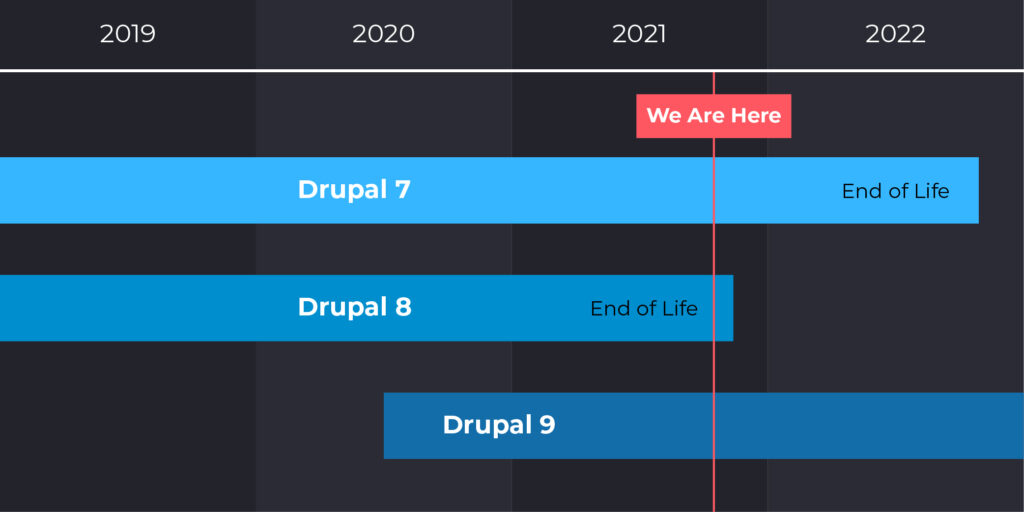Did you know that Drupal 7’s End of Life is moving to November 2022?. It means it no longer shares an end-of-life date with Drupal 8. (Drupal 8’s an end of life in November 2021). So, you should probably reconsider your upgrading plans. Are you wondering what’s next for your Drupal website or future project? Here is everything you need to know.

Let’s start with an explanation of the term “end of life,” or EOL. End of Life refers to the point at which a piece of software will no longer receive bug patches or security upgrades from its maintainers.
To give you a sense of scale, Drupal 7 will be nearly 11 years old in November 2022, and while it was originally slated to end of life in November 2021, it has now been extended until November 28, 2022. This is due to COVID-19’s worldwide and massive influence on businesses and their annual budgets.
Despite the fact that Drupal 8 is a newer version, it will be phased down before Drupal 7. Due to Symfony 3’s end of life, Drupal 8’s end of life is now planned for November 2, 2021. (Drupal has Symfony set as a dependency).
Related: AI & Drupal. How Smart Algorithms Could Impact Businesses?
Three Impacts of Drupal 7 And Drupal 8’s End of Life
#1 Drupal.org will cease to issue security updates, leaving your Drupal 7 or 8 website more exposed to hacking and security breaches.
#2 There will be no new modules or changes to current modules.
#3 Drupal community support will be limited, if not non-existent, in many situations, especially for Drupal 7.
Let’s look at some of the answers and start planning your Drupal upgrading strategy.
It’s crucial to remember that you’re not alone in this circumstance or with these concerns. In reality, Drupal 7 is being used by 4 out of 5 sites, and approximately 20-25 percent are still using Drupal 8.
If you’re upgrading from Drupal 8 to Drupal 9, the code will be pretty comparable, and there will be far less of a change (as long as all of your Drupal core and dependencies are up to date) than if you’re upgrading from Drupal 7.
Most major donated modules will function in Drupal 8 and Drupal 9, which is a significant change from the past because the codebases for these two versions will be relatively similar (unlike Drupal 7 and Drupal 8, which are vastly different).
What Happens After EOL?
Simply said, Drupal aims to keep moving forward as a contemporary platform with a strategic, efficient, and most importantly, secure one.
Drupal 8 and 9 are reliant on several different codebases or frameworks. When certain building blocks become deprecated and their communities no longer support them with security releases, updates, and upgrades, they must be updated in Drupal Core so that everything remains secure and functioning.
Symfony 3 is also Drupal 8’s most important requirement, will approach end-of-life in November 2021. When Symfony 3 is no longer supported, Drupal must switch to Symfony 4 or 5, which is where Drupal 9 is now.
Drupal Core maintainers have meticulously examined the codebase to determine which sections of Drupal’s API have dependencies that might cause Drupal 9 to fail. In Drupal 8, they were deprecated, and in Drupal 9, the team deleted them. As a result, deprecated building blocks are no longer in Drupal 9. Drupal Core maintainers will focus only on one supported Drupal version in November 2022, which is now Drupal 9.
This change also allows Drupal to establish itself as a contemporary, dependable, and secure platform capable of managing large, complex websites.
Related: Drupal Vs WordPress. Which Is The Best CMS For Your Business In 2020
With a primary emphasis on Drupal 9, module maintainers will have a clear roadmap for how future Drupal releases will affect them, allowing for more creativity and less anxiety about entire re-builds due to future version incompatibility.
What To Do Before EOL? Upgrade To Drupal’s Latest Versions
If your Drupal 8 site is in good shape and up to date, you shouldn’t have too much to worry about because the upgrade to Drupal 9 should be very painless.
However, due to the significant differences between Drupal 7 and Drupal 8, and Drupal 9, migrating from Drupal 7 will be more difficult. However, because Drupal 7’s End of Life is moving to November 2022, you now have considerably more time to prepare your project.
Let’s look at some frequent instances to assist you in figuring out how to go to Drupal 9.
What To Do When You Are Not Ready For A Rebuild?
The good news is that you now have additional time, more than a year. You can acquire the money, capacity, and time needed to rebuild and update your Drupal 7 website.
The Drupal Security Team will maintain an eye on the Drupal 7 core throughout this time. It continues providing security upgrades as needed until November 2022. It’s crucial to note that this extension will not affect the fact that Drupal 7 will no longer be actively maintained or developed in terms of new features.
While it may be tempting to take all of the extra time to postpone your update. In our expert opinion, use this spare time to plan and budget for your upgrade.
What Happens When You Hold Off a Little Longer?
If you’re ready to revamp your site, there’s no need to put it off. Suppose you have the finances and capacity to rebuild right now. In that case, you can work on rethinking your content, aesthetic design, fundamental functioning.
So, if you’re on Drupal 7, it’s generally preferable to skip Drupal 8 and go straight to Drupal 9. It means bypassing Drupal 8 and moving straight to the most stable version of Drupal.
Drupal 7 Has a Longer Life Than Drupal 8, What To Do?
Drupal 7 is an older product, but Drupal 9 represents the future and will provide a solid basis for your website for many years.
The best solution is to upgrade your Drupal 7 site to Drupal 9, which will effectively be a complete rebuild. There will be certain situations when this transition is more complex, but for the most part, it will be simple.
If you have a sophisticated site with specific features and need to keep your material, you can make an exception. If that’s the case, you’ll have to migrate as well.
Here at Agira technologies, we have successfully migrated sites with over 100,000 pages of content.
We can make Drupal future-friendly with the whole re-engineering of Drupal under the hood, between versions 7, 8, and 9. Hire a Drupal expert or partner with a Drupal expert like Agira technologies to guide you through the upgrade.






